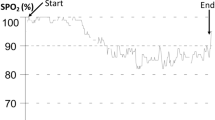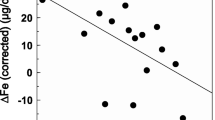Abstract
The pathophysiology of exercise related haemolysis is not thoroughly understood. We investigated whether exercise related haemolysis (1) is associated with alterations of red blood cell (RBC) membrane proteins similar to those found in inherited anaemic diseases, (2) can be induced with a non-running exercise mode, (3) is related to exercise intensity, and (4) coincides with indicators of oxidative stress. In ten triathletes [median (P25/P75-percentiles) age: 28.0 (26.3/28.5) years, height: 1.84 (1.78/1.87) m, body mass: 78.5 (74.8/80.8) kg, maximal oxygen uptake: 60.0 (57.3/64.8) ml kg−1 min−1], haptoglobin, α- and β-spectrin bands, malondialdehyde (MDA) and H2O2-induced chemiluminescence (H2O2-Chem) were determined immediately pre- and post-both, a 35 min low intensity and a high intensity cycling exercise [240 (218/253) vs 290 (270/300) W, P<0.05) requiring similar amounts of metabolic energy [28.3 (25.9/29.9) vs 24.9 (18.4/30.5) kJ kg−1, P>0.05]. At high exercise intensity haptoglobin [1.10 (0.81/2.53) vs 1.01 (0.75/2.00) g l−1] decreased (P<0.05) whilst MDA [2.80 (2.65/3.20) vs 3.13 (2.78/3.31) nmol ml−1] and H2O2-Chem [29.70 (22.55/37.10) vs 37.25 (35.20/52.63) rel. U min] increased (P<0.05), coinciding with the disappearance of the spectrin bands in six out of ten gels. No corresponding changes were found at low intensity exercise. Ten to 35 min of non-running exercise in a regularly used intensity domain causes intra-vascular haemolysis associated with alterations in the RBC membrane proteins similar to those found after in vitro oxidative stress and in inherited anaemic diseases like Sphaerocytosis and Fanconi’s anaemia.
Similar content being viewed by others
References
Agre P, Orringer EP, Bennet V (1982) Deficient red-cell spectrin in severe, recessively inherited spherocytosis. N Engl J Med 306:1155–1161
Beneke R (1995) Anaerobic threshold, individual anaerobic threshold, and maximal lactate steady state in rowing. Med Sci Sports Exerc 27(6):863–867
Beneke R (2003a) Maximal lactate steady state concentration (MLSS): experimental and modelling approaches. Eur J Appl Physiol 88:361–369
Beneke R (2003b) Methodological aspects of maximal lactate steady state – implications for performance testing. Eur J Appl Physiol 89:95–99
Beneke R (2003c) Experiment and computer aided simulation – complementary tools to understand exercise metabolism. Biochem Soc Trans 31(6):1263–1266
Beneke R, di Prampero PE (2001) Mechanische und metabolische Belastung beim Radfahren – eine Analyse aus physiologischer und biomechanischer Sicht. Dtsch Z Sportmed 51(1):29–33
Beneke R, Meyer K (1997) Walking performance in and economy in chronic heart failure patients pre and post exercise training. Eur J Appl Physiol 75:246–251
Beneke R, von Duvillard SP (1996) Determination of maximal lactate steady-state response in selected sports events. Med Sci Sports Exerc 28(2):241–246
Besso F (2000) Fanconi anaemia. Nippon Rinsho 58(7):1467–1472
Bichis M, Huber AR (2000) Hereditary diseases of erythrocyte membrane: from clinical aspects to underlying genetical and molecular mechanisms. Ann Biol Clin (Paris) 58(3):277–289
Burke LM, Read RSD (1987) Diet patterns of elite Australian male triathletes. Phys Sportsmed 15(2):140–155
Colt E, Heyman B (1984) Low ferritin levels in runners. J Sports Med Phys Fitness 24:13–17
Cooper CE, Vollaard NBJ, Choueiri T, Wilson MT (2002) Exercise, free radicals and oxidative stress. Biochem Soc Trans 30(2):280–285
Davidson RJ (1964) Exertional haemoglobinuria: a report on three cases with studies on the haemolytic mechanism. J Clin Path 17:536–540
Di Prampero PE (1986) The energy cost of human locomotion on land and in water. Int J Sports Med 7:55–72
Dufaux B, Hoederath A, Streitberger I, Hollmann W, Assmann G (1981) Serum ferritin, transferrin, haptoglobin and iron in middle and long distance runners, elite rowers, and professional racing cyclists. Int J Sports Med 2:43–46
Eber SW (1991) Disorders of the membrane skeleton of erythrocytes in hereditary spherocytosis and elliptocytosis: significance of the molecular defect for pathogenesis and clinical severity. Klin Padiatr 203(4):284–295
Ernst E, Sturmvoll M, Magyarosy I (1988) “Sportanämie” – Wohin verschwinden die Erythrozyten? Dtsch Z Sportmed 39:476–480
Falsetti JL, Burke ER, Feld RD, Frederick EC, Ratering C (1983) Hematological variations after endurance running with hard soled and air cushioned shoes. Phys Sports Med 11:118–127
Fleischer R (1881) Über eine neue Form von Hämoglobinurie beim Menschen. Berl Klin Wschr 18:691–695
Föhrenbach R (1991) Leistungsdiagnostik, Trainingsanalyse und –steuerung bei Läuferinnen und Läufern verschiedener Laufdisziplinen. Hartung-Gorre Verlag, Konstanz
Galea GA, Davidson RJ (1983) Haematological and haemorheological changes in marathon runners. Clin Hemorheol 3:320
Gehrmann G (1966) Mechanische Hämolysen. Dtsch Med Wschr 91:1846–1850
Gilligan DR, Altschulte MD, Katersky EM (1943) Physiological intravascular hemolysis of exercise, hemoglobinuria following cross-country runs. J Clin Invest 22:859–869
Guiliani AL, Bigoni B, Veronesi M, Manservigi R, Mischiati C, Berti G, Zavagli G, Ricci G (1999) Membrane protein pattern in hereditary spherocytosis in five subjects from north-east Italy obtained by SDS-PAGE using N’N’-diallyltartardiamide. Eur J Haematol 63(5):302–305
Hartmann U, Mader A, Petersmann G, Grabow V, Hollmann W (1989) Verhalten von Herzfrequenz und Laktat während ruderspezifischer Trainingsmethoden. Dtsch Z Sportmed 40(6):200–212
Hornbostel H, Kaufmann W, Siegenthaler W (1975) Pathophysiologie und Diagnostik hämolytischer Anämien. Dtsch Med Wschr 100:1400–1402
Hunding A, Jordal R, Paulev PE (1981) Runner’s anemia and iron deficiency. Acta Med Scand 209:315–318
Jordan J, Kiernan W, Merker HJ, Wenzel M, Beneke R (1998) Red cell membrane skeletal changes in marathon runners. Int J Sports Med 18:1–4
Kanzaki A, Wada H, Yawata Y (1991) Cytoskeleton anomalies in disorders of red cell membrane proteins. Rinsho Ketsueki 32(6):573–579
Mathur R, Chowdhury MR, Sigh G (2000) Recent advances in chromosome breakage syndromes and their diagnosis. Indian Pediatr 37(6):615–625
Miller BJ (1990) Haematological effects of running: a brief review. Sports Med 9:1–6
Poortmans JR, Haralambie G (1979) Biochemical changes in a 100 km run: proteins in serum and urine. Eur J Appl Physiol 40:245–254
Popov I, Lewin G, Gäbel W, von Baehr R (1989) Local and systemic effects of organ hypoxia detected by chemiluminescence and photochemiluminescence. Biomed Biochem Acta 49:297–300
Popov I, Volker H, Lewin G (2001) Photochemiluminescenct detection of antiradical activity. V. Application in combination with the hydrogen peroxide-initiated chemiluminescence of blood plasma proteins to evaluate antioxidant homeostasis in humans. Redox Rep 6(1):43–48
Resina AL, Gatteschi Giamberardino MA, Rubenni MG, Trabassi E, Troni MG (1988) Comparison of RBC indices and serum iron parameters in trained runners and control subjects. Haematologica 73:449–454
Röcker L, Laniado M, Kirsch K (1983) The effect of physical exercise on plasma volume and red blood cell mass. In: Dunn CDR (ed) Current concepts in Erythropoesis. Wiley, Chichester, pp 245–277
Schimke I, Papies B (1986) Einige methodische Aspekte der Bestimmung Thiobarbitursäureaktiver Substanzen im Plasma. Z Med Lab Diag 27:71–76
Selby GB, Eichner ER (1986) Endurance swimming, intravascular hemolysis, anaemia and iron depletion. Am J Med 81:791–794
Siegel AJ, Hennekens CH, Solomon HS, Van Boeckel B (1979) Exercise-related hematuria. JAMA 241(4):391–392
Smith JA, Kolbuch-Braddon M, Gillam I, Telford RD, Weidemann MJ (1995) Changes in the susceptibility of red blood cells to oxidative and osmotic stress following submaximal exercise. Eur J Appl Physiol 70:427–436
Snyder LM, Leb L, Piotrowsky J, Sauberman N, Liu SC, Fortier NL (1983) Irreversible spectrin-haemoglobin cross linking in vivo: a marker for red cell senescence. Br J Haematol 53:379–384
Straface E, Masella R, Principe DD, Franceschi C, Korkina LG, Zatterale A, Pagano G, Malorni W (2000) Spectrin changes occur in erythrocytes from patients with Fanconi’s anemia and their parents. Biochem Biophys Res Commun 273(3):899–901
Sumikawa K, Mu Z, Inoue T, Okochi T, Yoshida T, Adachi K (1993) Changes in erythrocyte membrane phospholipid composition induced by physical training and physical exercise. Eur J Appl Physiol Occup Physiol 67(2):132–137
Szygula Z (1990) Erythrocytic system under the influence of physical exercise and training. Sports Med 10:181–197
Telford RD, Cunningham RB (1991) Sex, sport and body-size dependency of hematology in highly trained athletes. Med Sci Sports Exerc 23:788–794
Telford RD, Sly GJ, Hahn AG, Cunningham RB, Bryant C, Smith JA (2003) Footstrike is the major cause of hemolysis during running. J Appl Physiol 94(1):38–42
Thompson JL, Manore MM, Skinner JS, Ravussin E, Spraul M (1995) Daily energy expenditure in male endurance athletes with differing energy intake. Med Sci Sports Exerc 27(3):347–354
Tse WT, Lux SE (1999) Red blood cell membrane disorders. Br J Haematol 104(1):2–13
Ubels FL, van Essen GG, de Jong PE, Stegeman CA (1999) Exercise induced macroscopic haematuria: run for a diagnosis? Nephrol Dial Transplant 14(8):2030–2031
Van Erp-Baart AM, Saris WH, Brinkhorst RA, Vos JA, Elvers JW (1989) Nationwide survey on nutritional habits in elite athletes. Int J Sports Med 10(Suppl1):S3–S10
Weight LM, Byrne M, Jacobs P (1991) Haemolytic effects of exercise. Clin Sci 81:147–52
Yoshimura H, Inoue T, Yamada T, Shiraki K (1980) Anemia during hard physical training and its causal mechanism with special reference to protein nutrition. Wld Rev Nutr Diet 35:1–86
Author information
Authors and Affiliations
Corresponding author
Rights and permissions
About this article
Cite this article
Beneke, R., Bihn, D., Hütler, M. et al. Haemolysis caused by alterations of α- and β-spectrin after 10 to 35 min of severe exercise. Eur J Appl Physiol 95, 307–312 (2005). https://doi.org/10.1007/s00421-005-0010-y
Accepted:
Published:
Issue Date:
DOI: https://doi.org/10.1007/s00421-005-0010-y




